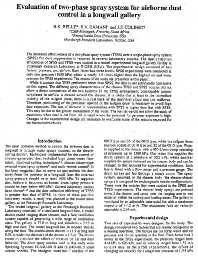Mining Publication: Evaluation of Two-Phase Spray System for Airborne Dust Control in a Longwall Gallery
Original creation date: September 2000
The increased effectiveness of a two-phase spray system (TPSS) over a single-phase system (SPSS) for dust suppression is reported in several laboratory studies. The dust collection efficiencies of SPSS and TPSS were studied in a model experimental longwall gallery facility at Pittsburgh Research Laboratory at NIOSH (USA). The experimental design consisted of two factors: pressure, and airflow. Each factor had three levels. SPSS experiments were conducted at only one pressure (1035 kPa) which is nearly 1.5 times higher that the highest air and water pressure for TPSS experiments. The results of the study are presented in this paper. While it appears that TPSS performed better than SPSS, the data is not sufficiently conclusive on this aspect. The differing spray characteristics of the chosen TPSS and SPSS nozzles did not allow a direct comparison of the two systems. In the TPSS arrangement, considerably greater turbulence in airflow is created around the shearer: it is likely that at least in the immediate vicinity of the tailgate drum, there is a roll back of the dust/mist cloud into the walkway. Therefore, positioning of the personnel upwind of the tailgate drum is necessary to avoid high dust exposures. The rate of decrease in concentration with TPSS is higher than that with SPSS. This may be due to the greater atomization of the water. The test set-up did not allow the study of conditions when coal is cut from tail to head where the potential for personal exposure is high. Changes in the experimental design are necessary to overcome some of the reasons expected for the inconclusive results.
Authors: BK Belle, RV Ramani, JF Colinet
Conference Paper - September 2000
NIOSHTIC2 Number: 20020885
Proc 12th Intl Conf on Coal Research, Sandton, Republic of South Africa, Sep 12-15, 2000 Wash, DC International Conference on Coal Research, 2000 Sep; :113-119
See Also
- Benchmarking Longwall Dust Control Technology and Practices
- Best Practices for Controlling Respirable Dust in Coal Mines
- Best Practices for Dust Control in Metal/Nonmetal Mining
- Discharge Water Handling and Treatment: Problems and Solutions at a Large Pittsburgh Seam Coal Mine
- The Effects of Water Emulsified Fuel on Diesel Particulate Matter Concentrations in Underground Mines
- Laboratory Testing To Quantify Dust Entrainment During Shield Advance
- Status of a Tapered Element, Oscillation Microbalance-Based Continuous Respirable Coal Mine Dust Monitor
- Technology News 447 - Dust Collector Discharge Shroud Reduces Dust Exposure to Drill Operators at Surface Coal Mines
- Technology News 486 - Floor Heaters Can Increase Operator's Dust Exposure in Enclosed Cabs
- Testing and Evaluation of an Inflatable Temporary Ventilation Control Device
- Page last reviewed: 4/1/2015
- Page last updated: 4/1/2015
- Content source: National Institute for Occupational Safety and Health, Mining Program


 ShareCompartir
ShareCompartir
